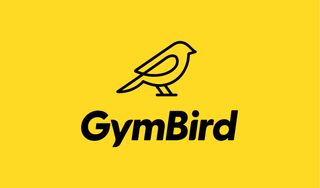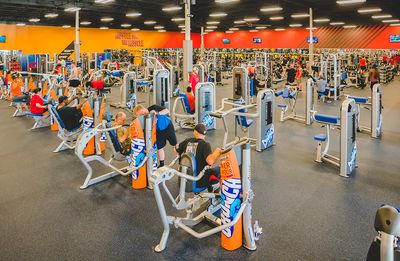
Starting a new workout routine means navigating new locations and learning skills, which can feel daunting if you aren't prepared. This is especially true if you don't have an athletic background that familiarized you with the weight room and how to use proper exercise form.
Starting an exercise routine should feel refreshing and empowering, not embarrassing or painful.
I'm going to share the wisdom I've acquired in my years of coaching to help you avoid common gym newbie mistakes.
Keep reading to discover the seven most common mistakes gym newbies make, what to do instead, and how to have the best possible experience on your way to better fitness.
GymBird Beginner Fitness Program
Best for beginner at-home routine
Access our 6 week at-home program, gain a strong fitness foundation, and start feeling your best all for less than the cost of a single month at a gym! Developed and demonstrated by certified personal trainer with over ten years of experience.
Instant access to 6-week workout plan
Demonstration videos for proper form
At-home workouts - minimal equipment needed
Mistake #1: Worrying About Other People
By far, the most common mistake I see beginners make is feeling intimidated or worrying about what other gym members think about them.
First, this is your gym, too. No matter your fitness level, how you look, or how much you know about exercise, you paid your membership dues, and you own this space just as much as everyone else.
Walk onto the gym floor with your head held high, and be proud that you are taking steps to improve your health and get fitter.
Second–and I cannot stress this enough–no one is looking at you.
Trust me, 99% of gym goers are wholly preoccupied with themselves and their workouts.
It can be easy to feel intimidated whenever we enter a new environment and feel inexperienced. But I know in the weight room, it can feel scary or uncomfortable to use equipment you aren't familiar with or not lift as much as the person next to you.
Remember this: Every champion and pro athlete started precisely where you are today.
The courage to show up and take imperfect action is the single biggest predictor of your success.
Mistake #2: Skipping the Warmup
When you're new to exercising, it's easy to overlook the warmup.
It's not sexy or gratifying, but performing a warmup is crucial for preventing injury and ensuring you perform your best during your workout.
Think about your fitness in terms of quality. The quality of your movement–not just how much and how often– will determine your success trajectory.
You'll reach your fitness goals faster and more safely if you warm up, use the proper form, and lift heavy enough to be challenged through the full range of motion.
The quality of your movement is determined by your form, your hydration and rest status, and, crucially: whatever warmup you did (or didn't do).
Warming up before any exercise is crucial and serves two purposes:
- It increases blood flow to all your muscles, preparing them for movement.
- It prepares the muscle groups you will work on, leading to better performance.
Never skip the warmup.
Mistake #3: Using Improper Form or Equipment
Using poor form or the wrong equipment for your goals is exceedingly common.
The human body is built to move, but that doesn't mean we come out of the womb knowing how to execute the perfect deadlift.
Strength training is not intuitive, so you must learn the form, like any other kinetic skill. Learning the basics of exercise programming also takes time, i.e., when to do which exercises to reach your goals.
As a new exerciser, you must work with a professional to learn the proper form and have someone take you through a program tailored to your goals.
Good programming + Hard work + Adequate recovery = Progress
Look for a certified personal trainer with 1-2 years of experience, and if you have particular needs to be accommodated, (accessibility, mobility, , etc.), make sure your trainer has experience catering to your specific needs.
Without the proper instruction, improper exercise form or haphazard programming can lead to injuries at worst and stalled or non-existent progress at best.
Mistake #4: Overtraining
Starting a new workout routine can feel thrilling, and once you hit your groove, it's easy to think more training will result in more progress. However, that's not the case. Because, as with most things in human performance, your fitness progress is not linear.
Linear growth would mean you could train harder and harder, adding more and more weight/difficulty to your workouts, and your progress would go on indefinitely. But humans are not super robots, and our bodies are incapable of infinite growth. Instead, we find that some pressure is good, leading to growth and adaptation.
Think about a time when you were on a deadline for work or school. You were working against the clock and feeling the squeeze. But in the end, that added pressure led to your best work.
Or maybe you played sports and remember the electric feeling of hearing the crowd roar at the championship game, making you play harder and better than ever.
Some mental arousal–or pressure–is good for us and can improve performance. Too much stress, however, and our performance will tank. This is called an Inverted-U Theory, coined by two psychologists, which describes the relationship between mental arousal and performance.
While this theory describes our mental state and performance, it's a great segue into how physical stress affects our body.
When we work out, we are stressing our bodies to elicit an adaptation. Typically bigger muscles, smaller fat cells, more efficient heart and lungs - you get the picture.
We need a new stimulus level to force the body to change, but too much stimulus (or insufficient rest) will hijack the process and lead to mental burnout, injury, and subpar adaptation. This is called overtraining, a mistake many new exercisers make.
Overtraining is not just sore muscles but describes the persistent fatigue, feelings of burnout, and decreasing performance you can experience if you exercise too much without enough recovery consistently.
As you can see from the above graph, performance only trends upward when adequate recovery is observed. So what does this mean for you?
A good exercise program ensures you get enough rest between reps/sets during your workout and between workouts. Without it, you're at risk for musculoskeletal injury, mental fatigue, and falling off your exercise program.
All of these will put you behind on your fitness goals and defeat the purpose of the exercise in the first place. Too many high-intensity or high-impact workouts or training six or seven days a week may leave you feeling drained.
Regular exercise should boost your mood, so if you find yourself consistently exhausted, hungry, or grumpy–seek out a fitness professional to look at your programming and help you find that sweet spot between stress and performance.
Check out our Ultimate Guide to Strength Training to learn more about strength training programming.
Mistake #5: Focusing Too Much on Cardio
Many people start exercising to lose weight. And many more people think that cardio is the best exercise for weight loss, so that's all they do. There are a few problems with this, but we'll stick with the basics.
According to The U.S. Department of Health & Human Services, we should get at least 150 minutes of moderate-intensity cardio exercise AND two days of strength training weekly.
Cardio is required for heart health, longevity, weight management, and disease prevention. Strength training is required for injury prevention, function and performance, body composition, and bone density.
Both types of exercise are essential for our health and performance, but many gym newbies pursue cardio relentlessly.
In my experience, most people need to lift weights 3-4x weekly to maintain lean mass, achieve their physique goals, and reap all the health benefits in addition to 2-3 weekly cardio sessions.
If you're new to the gym and don't know where to start, linking up with a qualified personal trainer can make all the difference.
Mistake #6: Changing Workouts/Exercises Frequently
A common mistake new exercisers make is randomly skipping from one workout or exercise to another with no tailored plan.
Most strength training programs run for at least four weeks, often much longer, so you must stick to your program to see progress.
Many newbies get distracted by the latest exercise being touted by their favorite social media influencers and switch exercises and workouts randomly. This is highly ineffective.
Remember that your progress depends on progressive overload and consistency.
Advanced exercisers repeat the same movement patterns and change only one variable at a time for the entire training block.
Your muscles need to be challenged and fueled systematically.
Mistake #7: Impatience
The biggest mistake I see from gym newbies and advanced lifters alike is not understanding that patience is the key to transformation. This is true for all fitness goals, but especially if you are trying to change how your body looks.
Changing your physique is just like growing a tree. If you wanted to grow a huge willow tree in your front yard, what would you do first? You'd likely do some research, find out if Willow trees can thrive in your climate, and maybe poke around the yard for the perfect spot.
Then you'd buy and plant the seeds carefully–following every direction. You'd ensure the spot you chose had enough sunlight, and the conditions were just right.
Then tomorrow, you would check on your spot in the dirt, give it some water if needed, and go about your day. Rinse and repeat every day for years.
Changing your body dramatically demands the exact same process and mindset: deliberate consistency and patience.
Seeing results from your workouts requires you to focus on the daily growth habits consistently for many months:
- Lifting and hitting cardio consistently
- Eating enough protein and plenty of veggies and fruits
- Managing your stress
- Getting enough sleep
If you walked out to your dirt patch a few weeks after planting your seeds, would you throw a fit that a 30-foot tree hadn't sprouted yet? No, of course not!
Because you know that growing a healthy mature tree takes a very long time. But for some reason, when it comes to changing how our body looks, many of us struggle with patience.
If you're just starting your fitness journey, I implore you to focus on the process and avoid common gym mistakes. Fall in love with the daily wins and achievements of caring for yourself.
Changing your body takes a long time and a lot of commitment. If you're staring in the mirror daily, willing yourself to change, you will likely get discouraged and quit. Instead, focus on setting process vs. product goals and how exercise makes you feel–mentally and physically.
For example, I will work out four times weekly for three months.
Vs.
I will lose 20 pounds in the next three months.
You have far more control over the process than you do the end result.
By focusing on process goals, you can celebrate the victories each week without getting caught up in the agonizing game of chicken with the scale.
Get our fitness newsletter
Stay on track with your fitness goals and get inspired! Sign up for the GymBird newsletter for twice-monthly expert fitness and nutrition tips.
Most Asked Questions by Gym Newbies
How do I prevent injuries in the gym?
To avoid injuries in the gym, you must consistently prioritize these three things:
- Never skip your warm-up
- Work with a professional to learn proper lifting techniques
- Prioritize recovery, including hydration, nutrition, and rest
How do I set fitness goals?
Personal trainers are taught the S.M.A.R.T. method of goal setting. Make sure your health goal meets the following criteria:
S - Specific
M - Measurable
A -Attainable
R - Relevant
T - Time-bound
Using this method, you'll set goals you can achieve, making you feel accomplished and capable. Those feelings will then help you stick with your fitness routine.
How important is drinking water?
Hydration is vital as dehydration during exercise can leave you dizzy with less endurance and focus.
Most adults should drink between 2-4 liters of water. But you can use this free calculator to figure out your specific hydration goal.
Do I have to stretch after working out?
You don't have to stretch every day, but it's essential to incorporate some flexibility work a few times weekly to prevent injury and increase your performance.
You can also incorporate some activation work that includes active stretches in your arm-up for maximum efficiency.
What are the most common injuries for beginners?
- Muscle strains & sprains
- Shin splints
- Knee pain
- Shoulder pain
The most common cause of these injuries is poor lifting form, overuse, and going too heavy with your weights.
All of those can be avoided by learning the proper exercise form and paying a professional (or an app) to write a solid program for you.
How do I find a great personal trainer?
If you've ever worked with a personal trainer before, make sure they meet the following criteria:
- They have expertise in your goal area.
- They listen to you and perform a thorough assessment, including a medical questionnaire and exercise history.
- They're flexible and compassionate.
Don't write off a trainer just because they look a certain way. Coaching knowledge and your trainer's appearance have little correlation.
Are there exercises I shouldn't do as a beginner?
There is no list of exercises I would ward beginners off, but that said, many barbell movements, such as the squat, deadlift, snatch, and clean, are advanced and take time to learn.
Make sure if you're interested in learning those movements, you work closely with a qualified professional.
Why is lifting with proper form so important?
I harp on lifting form so much because I have personally seen many injuries that could have been prevented, some of them life-altering.
Lifting weights is not more dangerous than other athletic pursuits, but it does come with risks–especially when performed poorly.
Take the time to learn the moves and gain mastery over them before you start increasing the weight or intensity of your workouts. You'll thank me later.
How many times should I work out per week?
Working out 2-4 hours throughout the week is enough for most people. Just make sure you're getting your strength training and cardio in.
It hurts when I exercise. What do I do?
It's crucial to understand the difference between muscular soreness and pain.
Muscle soreness is often an achy feeling that occurs within 24-48 hours after
exercise that is bilateral and equal. Meaning both your arms are sore equally, both your legs are sore equally, etc.
On the other hand, pain is often felt in the joints or is unilateral, sharp, stabbing, or aching and is isolated to a particular area.
If you experience pain during an exercise, stop immediately and rest.
Sometimes, you only need to reduce your weight or intensity, and the pain will resolve.
If not, nix the exercise altogether and proceed cautiously to a different exercise (or call it a day).
Bottom Line
Most gym mistakes are easy to avoid. Always warm up and work with a fitness professional to learn the proper form and receive an effective exercise program tailored to your goals.
Avoid overtraining by prioritizing your recovery and have a balanced workout program with cardio, strength, flexibility, endurance, and power.
Stick with one training program for at least 4-6 weeks, and don't worry about anyone else at the gym. This is your gym too, and you belong!
Starting a new gym routine as a first-time exerciser can feel intimidating, but with the right resources to guide you past common gym mistakes and a positive attitude, you will feel confident and capable in no time.
Remember that changing your body is like growing a tree, so focus on the process and enjoy the fruits of your labor daily.
More Gyms Reviews and Advice
- Best Gyms for Beginners
- Best Gyms for Students
- Best Gyms for Personal Trainers
- Best Gyms for Weight Loss
- Best Gyms for Women
- Best Gyms for Travelers
- Best Gyms for Seniors
Resources
NASM. 19 Signs of Overtraining: How to Avoid Excess Fatigue and OTS.
U.S. Department of Health and Human Services. Current Physical Activity Guidelines for Americans.




